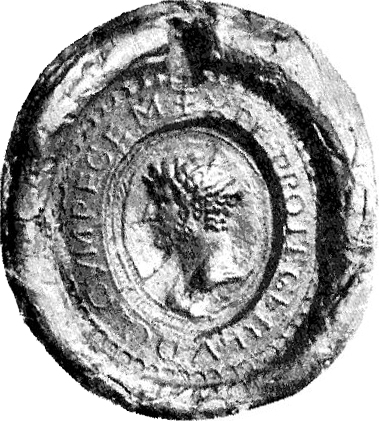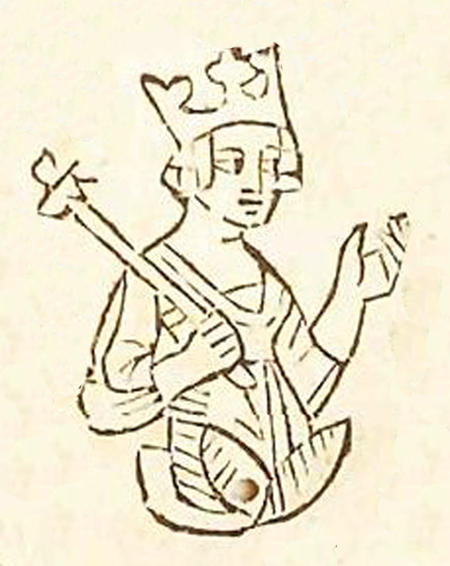|
Albert I, Holy Roman Emperor
Albert I of Habsburg () (July 12551 May 1308) was a Duke of Austria and Styria from 1282 and King of Germany from 1298 until his assassination. He was the eldest son of King Rudolf I of Germany and his first wife Gertrude of Hohenberg. Sometimes referred to as 'Albert the One-eyed' because of a battle injury that left him with a hollow eye socket and a permanent snarl. Biography From 1273 Albert ruled as a landgrave over his father's Swabian ( Further Austrian) possessions in Alsace. In 1282 his father, the first German monarch from the House of Habsburg, invested him and his younger brother Rudolf II with the duchies of Austria and Styria, which he had seized from late King Ottokar II of Bohemia and defended in the 1278 Battle on the Marchfeld. By the 1283 Treaty of Rheinfelden his father entrusted Albert with their sole government, while Rudolf II ought to be compensated by the Further Austrian Habsburg home territories – which, however, never happened until his death in 1 ... [...More Info...] [...Related Items...] OR: [Wikipedia] [Google] [Baidu] |
King Of Germany
This is a list of monarchs who ruled over East Francia, and the Kingdom of Germany (), from Treaty of Verdun, the division of the Francia, Frankish Empire in 843 and Dissolution of the Holy Roman Empire, the collapse of the Holy Roman Empire in 1806 until German Revolution of 1918–1919, the collapse of the German Empire in 1918: East Francia (843–962) Carolingian dynasty Conradine dynasty Ottonian dynasty Holy Roman Empire (962–1806) The title "King of the Romans", used in the Holy Roman Empire, was, from the coronation of Henry II, considered equivalent to King of Germany. A king was chosen by the German electors and would then proceed to Rome to be Coronation of the Holy Roman Emperor, crowned emperor by the pope. Ottonian dynasty (continued) Salian dynasty Supplinburger dynasty Hohenstaufen dynasty Interregnum Changing dynasties Habsburg dynasty Modern Germany (1806–1918) Confederation of the Rhine (1806–1813) German Confederation (18 ... [...More Info...] [...Related Items...] OR: [Wikipedia] [Google] [Baidu] |
Albert II, Duke Of Austria
Albert II (; 12 December 1298 – 16 August 1358), known as ''the Wise'' () or ''the Lame'' (), a member of the House of Habsburg, was duke of Austria and Styria from 1330, as well as duke of Carinthia and margrave of Carniola from 1335 until his death. Biography Albert II was born at Habsburg Castle in Swabia, a younger son of King Albert I of Germany and his wife Elisabeth of Carinthia, a member of the House of Gorizia (''Meinhardiner''). He initially prepared for an ecclesiastical career and, though still a minor, was elected Bishop of Passau in 1313. However, he had to rival with an opposing candidate and finally renounced the office in 1317. After the death of their elder brother Frederick the Fair in 1330, the surviving sons Albert II and Otto the Merry became joint rulers of all Habsburg dominions in Austria and Styria. Albert was able to further increase his possessions by the inheritance of his wife Joanna of Pfirt, which was made up of the Alsatian county of Pfi ... [...More Info...] [...Related Items...] OR: [Wikipedia] [Google] [Baidu] |
Landgrave
Landgrave (, , , ; , ', ', ', ', ') was a rank of nobility used in the Holy Roman Empire, and its former territories. The German titles of ', ' ("margrave"), and ' ("count palatine") are of roughly equal rank, subordinate to ' ("duke"), and superior to the rank of a ' ("count"). Etymology The English word landgrave is the equivalent of the German ''Landgraf'', a compound of the words ''Land'' and ''Graf'' (English: Count). Description The title referred originally to a count who possessed imperial immediacy, or a feudal duty owed directly to the Holy Roman Emperor. His jurisdiction stretched over a sometimes quite considerable territory, which was not subservient to an intermediate power, such as a duke, a bishop or count palatine. The title originated within the Holy Roman Empire (first recorded in Lower Lotharingia from 1086: Henry III, Count of Louvain, as landgrave of Brabant). By definition, a landgrave exercised sovereign rights. His decision-making power was compar ... [...More Info...] [...Related Items...] OR: [Wikipedia] [Google] [Baidu] |
Rudolf I Of Germany
Rudolf I (1 May 1218 – 15 July 1291) was the first King of Germany of the Habsburg dynasty from 1273 until his death. Rudolf's imperial election of 1273, election marked the end of the Interregnum (Holy Roman Empire), Great Interregnum which had begun after the death of the Hohenstaufen Emperor Frederick II in 1250. Originally a Duke of Swabia, Swabian count, he was the first Habsburg to acquire the duchies of Duchy of Austria, Austria and Duchy of Styria, Styria in opposition to his mighty rival, the Přemyslid dynasty, Přemyslid king Ottokar II of Bohemia, whom he defeated in the 1278 Battle on the Marchfeld. The territories remained under Habsburg rule for more than 600 years, forming the core of the Habsburg monarchy and the present-day country of Austria. Rudolf played a vital role in raising the comital House of Habsburg to the rank of Princes of the Holy Roman Empire, Imperial princes. Early life Rudolf was born on 1 May 1218 at Limburgh Castle near Sasbach am Kais ... [...More Info...] [...Related Items...] OR: [Wikipedia] [Google] [Baidu] |
List Of German Monarchs
This is a list of monarchs who ruled over East Francia, and the Kingdom of Germany (), from Treaty of Verdun, the division of the Francia, Frankish Empire in 843 and Dissolution of the Holy Roman Empire, the collapse of the Holy Roman Empire in 1806 until German Revolution of 1918–1919, the collapse of the German Empire in 1918: East Francia (843–962) Carolingian dynasty Conradine dynasty Ottonian dynasty Holy Roman Empire (962–1806) The title "King of the Romans", used in the Holy Roman Empire, was, from the coronation of Henry II, considered equivalent to King of Germany. A king was chosen by the German electors and would then proceed to Rome to be Coronation of the Holy Roman Emperor, crowned emperor by the pope. Ottonian dynasty (continued) Salian dynasty Supplinburger dynasty Hohenstaufen dynasty Interregnum Changing dynasties Habsburg dynasty Modern Germany (1806–1918) Confederation of the Rhine (1806–1813) German Confederation (18 ... [...More Info...] [...Related Items...] OR: [Wikipedia] [Google] [Baidu] |
Duchy Of Styria
The Duchy of Styria (; ; ) was a duchy located in modern-day southern Austria and northern Slovenia. It was a part of the Holy Roman Empire until its dissolution in 1806 and a Cisleithanian crown land of Austria-Hungary until its dissolution in 1918. History It was created by Emperor Frederick Barbarossa in 1180 when he raised the March of Styria to a duchy of equal rank with neighbouring Carinthia and Bavaria, after the fall of the Bavarian Duke Henry the Lion earlier that year. Margrave Ottokar IV thereby became the first duke of Styria and also the last of the ancient Otakar dynasty. As Ottokar had no issue, he in 1186 signed the Georgenberg Pact with the mighty House of Babenberg, rulers of Austria since 976, after which both duchies should in perpetuity be ruled in personal union. Upon his death in 1192, Styria as stipulated fell to the Babenberg Leopold V, Duke of Austria. The Austrian Babenbergs became extinct in 1246, when Duke Frederick II was killed in bat ... [...More Info...] [...Related Items...] OR: [Wikipedia] [Google] [Baidu] |
List Of Rulers Of Austria
From 976 until 1246, the Margraviate of Austria and its successor, the Duchy of Austria, was ruled by the House of Babenberg. At that time, those states were part of the Holy Roman Empire. From 1246 until 1918, the duchy and its successor, the Archduchy of Austria, was ruled by the House of Habsburg. Following the defeat of Austria-Hungary in World War I, the titles were abolished or fell into abeyance with the erection of the modern Republic of Austria. Margraves and Dukes of Austria under the House of Babenberg The March of Austria, also known as ''Marcha Orientalis'', was first formed in 976 out of the lands that had once been the March of Pannonia in Carolingian times. The oldest attestation dates back to 996, where the written name "ostarrichi" occurs in a document transferring land in present-day Austria to a Bavarian monastery. In 1156, the Privilegium Minus elevated the march to a duchy, independent of the Duchy of Bavaria. Dukes and Archdukes of Austria unde ... [...More Info...] [...Related Items...] OR: [Wikipedia] [Google] [Baidu] |
Catherine Of Austria, Duchess Of Calabria
Katherine (), also spelled Catherine and other variations, is a feminine given name. The name and its variants are popular in countries where large Christian populations exist, because of its associations with one of the earliest Christian saints, Catherine of Alexandria. In the early Christian era it came to be associated with the Greek adjective (), meaning 'pure'. This influenced the name's English spelling, giving rise to variants ''Katharine'' and ''Catharine''. The spelling with a middle 'a' was more common in the past. ''Katherine'', with a middle 'e', was first recorded in England in 1196 after being brought back from the Crusades. Popularity and variations Anglophone use In Britain and America, ''Catherine'' and its variants have been among the 100 most popular names since 1880. Amongst the most common variants are ''Katherine'' and ''Kathryn''. The spelling ''Catherine'' is common in both English and French. Less-common variants in English include ''Katharine ... [...More Info...] [...Related Items...] OR: [Wikipedia] [Google] [Baidu] |
Elisabeth Of Austria, Duchess Of Lorraine
Elisabeth of Austria (c. 1285 – 19 May 1353), also known as Isabelle, was List of Lorrainian royal consorts, Duchess of Lorraine as the wife of Frederick IV, Duke of Lorraine, Duke Frederick IV, and regent of Lorraine during the minority of their son Rudolph, Duke of Lorraine, Rudolph from 1329 until 1331. She was also a member of the House of Habsburg. Life Elisabeth was the tenth of twelve children to King Albert I of Habsburg and his wife Queen Elisabeth of Gorizia-Tyrol. She was the sister of King Rudolph I of Bohemia, King Frederick the Fair, Leopold I, Duke of Austria, Albert II, Duke of Austria, Otto, Duke of Austria, Agnes of Austria (1281-1364), Agnes, Queen of Hungary and Anna of Austria (1275–1327), Anna, Margravine of Brandenburg. Duchess of Lorraine Elisabeth was betrothed at a young age to one of the sons of Philip IV of France, so her father could make stronger connections with France. On May 25, 1300, Elisabeth's eldest brother Rudolph I of Bohemia married ... [...More Info...] [...Related Items...] OR: [Wikipedia] [Google] [Baidu] |
Agnes Of Austria (1281–1364)
Agnes of Austria (18 May 1281 – 10 June 1364) was Queen of Hungary by marriage to Andrew III of Hungary. Life Agnes was a daughter of Albert I, King of Germany and his wife, Elisabeth of Tirol. By birth, she was member of the House of Habsburg and a by marriage the Queen of Hungary. Queen On 13 February 1296 in Vienna, Agnes married Andrew III of Hungary. Afterwards, with his father-in-law's support, Andrew managed to defeat the revolt of Miklós Kőszegi and Máté Csák III, and occupy the castles of Kőszeg and Pozsony. In 1298 Andrew supported with troops his father-in-law's revolt against King Adolf of Germany. Agnes disliked tournaments, but liked sermons. Since she was small of stature, she used to wear dresses her sisters no longer wanted, which gained her praise for modesty. The death of Andrew III on 14 January 1301, at Buda, ended the male line of the Árpáds. Stephen Ákos, one of his contemporaries called him "the last golden twig of the Árpáds". Later ... [...More Info...] [...Related Items...] OR: [Wikipedia] [Google] [Baidu] |





